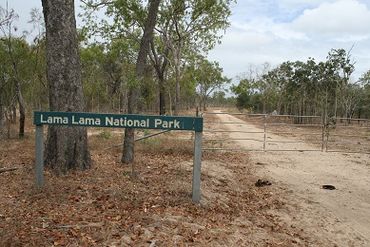Lama Lama National Park facts for kids
Quick facts for kids Lama Lama National ParkQueensland |
|
|---|---|
|
IUCN Category II (National Park)
|
|
 |
|
| Nearest town or city | Coen |
| Established | 2008 |
| Area | 355.6 km2 (137.3 sq mi) |
| Managing authorities | Queensland Parks and Wildlife Service |
| Website | Lama Lama National Park |
| See also | Protected areas of Queensland |
Lama Lama National Park is a special place in Far North Queensland, Australia. It is located on the Cape York Peninsula. The park gets its name from the Lama Lama people. They are the traditional owners of this land.
This park helps protect beautiful coastal plains. It also protects sandy hills and beach ridges. These areas are part of the Annie River water system. The Annie River forms the southern edge of the park.
Lama Lama National Park was the first national park in Queensland to be managed in a unique way. It is managed jointly by the traditional owners and the Government of Queensland. This special agreement was made on July 10, 2008.
Where is Lama Lama National Park?
Lama Lama National Park is about 70 kilometers (43 miles) southeast of a town called Coen. It is in an area known as Yarraden. The eastern side of the park touches Princess Charlotte Bay. It also borders Lakefield National Park.
The park covers a large area of 355.6 square kilometers (137.3 square miles). Inside the park, there are two special areas. These are called Allngna Wungku Living Area and Goose Swamp and Bull Swamp Area.
Wetlands and Water
Lama Lama National Park has many wetlands. Wetlands are areas where water covers the land. There are about 39 wetlands in the park. They make up about 5% of the park's total area. These wetlands are important for many plants and animals.
The land that became the park used to be two properties. They were known as Running Creek and Lilyvale.
Plants and Animals
The park is home to important plant species. One example is the Eucalyptus tetrodonta. This tree is also known as Darwin stringybark.
Lama Lama National Park also protects special animals. It is a safe home for the critically endangered Red goshawk. Critically endangered means this bird is very close to disappearing forever. Protecting its home in the park helps it survive.


